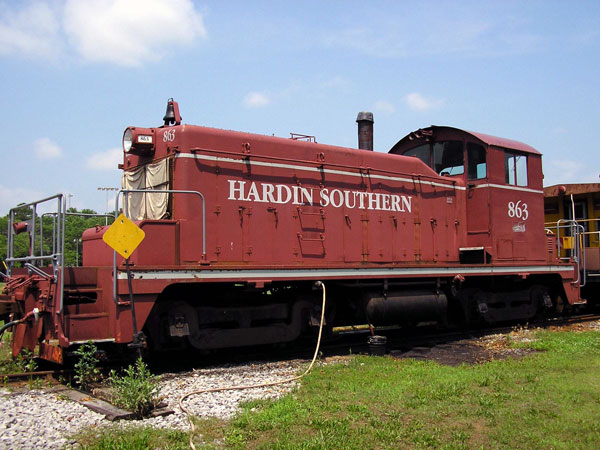Posts: 1,291
Threads: 64
Joined: May 2011
I was wondering how long it would take to warm up a diesel engine (lets say a first generation switcher) from the off position to full warmup in order to operate and how long from operation to cols stop/shot off?
Mike Kieran
Port Able Lines
" If the world were perfect, it wouldn't be " - Yogi Berra.
Posts: 5,263
Threads: 195
Joined: Apr 2009
I did ones read that a cold Geep needed at least an hour until it could be used to haul freight.
Reinhard
Posts: 4,553
Threads: 100
Joined: Dec 2008
The C&NW would keep the engines running, especially during the winter when things could freeze up. The start up time, and the risk of mechanical failures during start-up, made the fuel usage " an economical thing to do".
We always learn far more from our own mistakes, than we will ever learn from another's advice.
The greatest place to live life, is on the sharp leading edge of a learning curve.
Lead me not into temptation.....I can find it myself!
Posts: 1,291
Threads: 64
Joined: May 2011
I would have considered that, but I figure that I will running a short line that works one shift per day. I'll have an engine house to keep the engine warm. I just figure that the Port Able Railway would have 2-3 employees and run a small budget operation.
Mike Kieran
Port Able Lines
" If the world were perfect, it wouldn't be " - Yogi Berra.
Posts: 5,263
Threads: 195
Joined: Apr 2009
Mike Kieran Wrote:I would have considered that, but I figure that I will running a short line that works one shift per day. I'll have an engine house to keep the engine warm. I just figure that the Port Able Railway would have 2-3 employees and run a small budget operation.
It depends on the location, time and engine you are modeling. Older engines did not have facilities to prevent them from freezing and that would lead to a cracked engine! Those engines "must not" be parked at freezing temperatures with the engine shut off or the engine must be prepared to do so by removing all water etc. That has never been done for just one night.
Only modern engines have similar facilities like automobiles when it became more cost effective to invest in extra engine facilities than the fuel running idle all night.
Two links:
http://www.hotstart.com/home/markets/railroad/
http://answers.yahoo.com/question/index?...007AAGcLHk
Reinhard
Posts: 9,759
Threads: 234
Joined: Dec 2008
Our s-1 ALCO manual said normal operating temprature was 180 degrees. In 14 years I never saw it over 160, even working hard. The GP7 would reach temprature for the shutters to open but we only waited until we had air pumped before we went to work which was only about 4 minutes with either locomotive. They are much like your automobile, they will warm up while working, and with todays fuel cost we never let them run more than needed.
Charlie
Posts: 1,263
Threads: 45
Joined: Feb 2010
For what it's worth; on the F&C all the engines (both GE 70 ton and ALCO S-2/S-4) were kept inside the concrete block engine house. We simply started them up, let the air system charge, then after a quick test of the engine brakes, we knocked off the hand brake and off we went. No warm up time to speak of.
On the L&N we kept two engines in Frankfort all the time and they were kept running 24/7 in the winter months but shut down in warm weather. As mentioned in a previous message, if you had to shut one of them down in cold weather (below 40 degrees) the cooling system water had to be drained to prevent freezing and damage to the engine block.
I've noticed that a lot of the short line operations that I've visited in Indiana and other locations usually have what I assume are electric crankcase heaters installed and are shut down, but kept plugged in to an electrical outlet when not in use. About the same as you do with diesel trucks and buses. You can see an example of this here:

Ed
"Friends don't let friends build Timesavers"
Posts: 612
Threads: 10
Joined: Feb 2011
Excellent topic Mike.
I had never really thought through the implications of cold starts and cold weather as it applies to the Effingham Railroad. I know that EFRR 2716 [SW 1200] is kept inside the TQW warehouse, while ILW 7570 is most frequently parked on the Hodgson Mill siding which may indicate access to an outside power point for a possible crankcase heater.
Mark
Fake It till you Make It, then Fake It some More
Posts: 2,418
Threads: 63
Joined: Dec 2008
Same considerations apply to diesel buses. Decades ago, I was at TTC's Eglinton station on a winter weekend and there was quite a fog coming from the far platforms (rush hour only) which were stuffed with idling diesels.
This apparently was a consideration when keeping trolley coaches as they could be stored outside all winter. Didn't matter that they were freezing cold for the first passengers of the morning.
David
Moderato ma non troppo
Perth & Exeter Railway Company
Esquesing & Chinguacousy Radial Railway
In model railroading, there are between six and two hundred ways of performing a given task.
Most modellers can get two of them to work.



